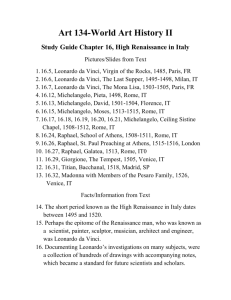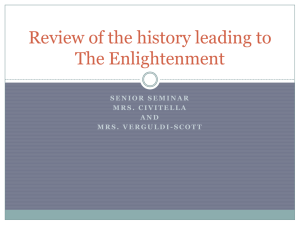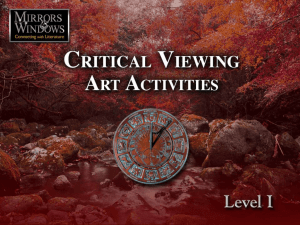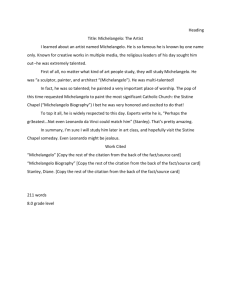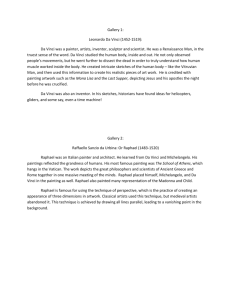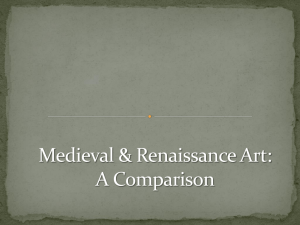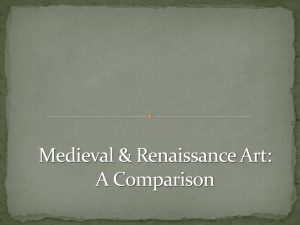- Ms. Michel`s History Class
advertisement
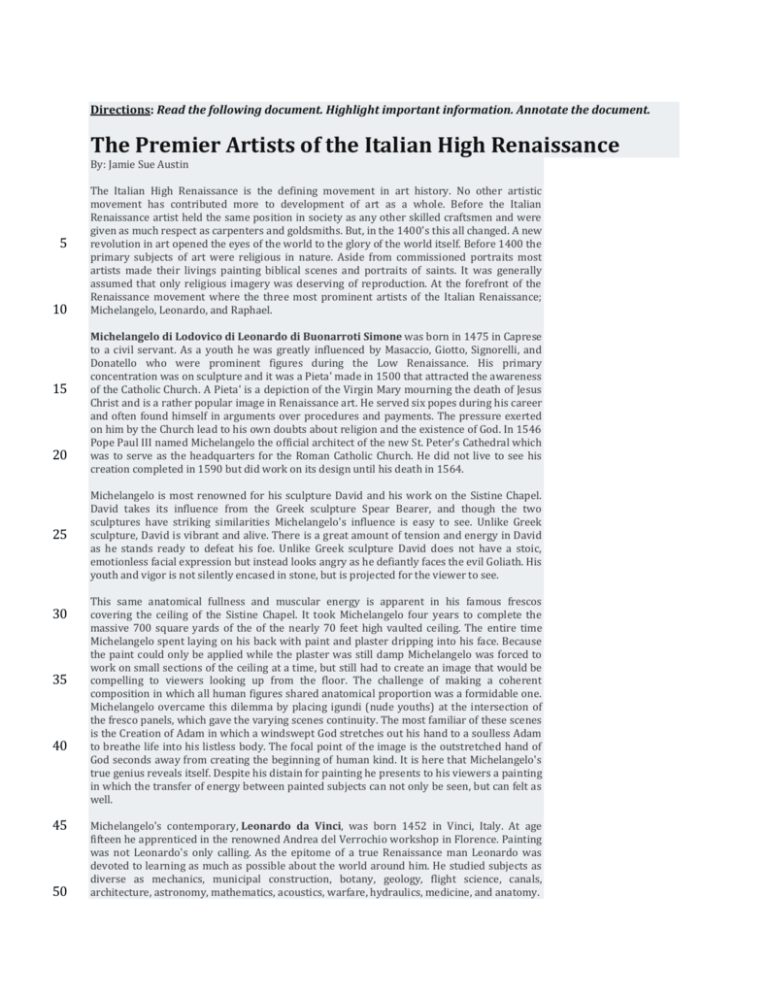
Directions: Read the following document. Highlight important information. Annotate the document. The Premier Artists of the Italian High Renaissance By: Jamie Sue Austin 5 10 15 20 25 30 35 40 45 50 The Italian High Renaissance is the defining movement in art history. No other artistic movement has contributed more to development of art as a whole. Before the Italian Renaissance artist held the same position in society as any other skilled craftsmen and were given as much respect as carpenters and goldsmiths. But, in the 1400's this all changed. A new revolution in art opened the eyes of the world to the glory of the world itself. Before 1400 the primary subjects of art were religious in nature. Aside from commissioned portraits most artists made their livings painting biblical scenes and portraits of saints. It was generally assumed that only religious imagery was deserving of reproduction. At the forefront of the Renaissance movement where the three most prominent artists of the Italian Renaissance; Michelangelo, Leonardo, and Raphael. Michelangelo di Lodovico di Leonardo di Buonarroti Simone was born in 1475 in Caprese to a civil servant. As a youth he was greatly influenced by Masaccio, Giotto, Signorelli, and Donatello who were prominent figures during the Low Renaissance. His primary concentration was on sculpture and it was a Pieta' made in 1500 that attracted the awareness of the Catholic Church. A Pieta' is a depiction of the Virgin Mary mourning the death of Jesus Christ and is a rather popular image in Renaissance art. He served six popes during his career and often found himself in arguments over procedures and payments. The pressure exerted on him by the Church lead to his own doubts about religion and the existence of God. In 1546 Pope Paul III named Michelangelo the official architect of the new St. Peter's Cathedral which was to serve as the headquarters for the Roman Catholic Church. He did not live to see his creation completed in 1590 but did work on its design until his death in 1564. Michelangelo is most renowned for his sculpture David and his work on the Sistine Chapel. David takes its influence from the Greek sculpture Spear Bearer, and though the two sculptures have striking similarities Michelangelo's influence is easy to see. Unlike Greek sculpture, David is vibrant and alive. There is a great amount of tension and energy in David as he stands ready to defeat his foe. Unlike Greek sculpture David does not have a stoic, emotionless facial expression but instead looks angry as he defiantly faces the evil Goliath. His youth and vigor is not silently encased in stone, but is projected for the viewer to see. This same anatomical fullness and muscular energy is apparent in his famous frescos covering the ceiling of the Sistine Chapel. It took Michelangelo four years to complete the massive 700 square yards of the of the nearly 70 feet high vaulted ceiling. The entire time Michelangelo spent laying on his back with paint and plaster dripping into his face. Because the paint could only be applied while the plaster was still damp Michelangelo was forced to work on small sections of the ceiling at a time, but still had to create an image that would be compelling to viewers looking up from the floor. The challenge of making a coherent composition in which all human figures shared anatomical proportion was a formidable one. Michelangelo overcame this dilemma by placing igundi (nude youths) at the intersection of the fresco panels, which gave the varying scenes continuity. The most familiar of these scenes is the Creation of Adam in which a windswept God stretches out his hand to a soulless Adam to breathe life into his listless body. The focal point of the image is the outstretched hand of God seconds away from creating the beginning of human kind. It is here that Michelangelo's true genius reveals itself. Despite his distain for painting he presents to his viewers a painting in which the transfer of energy between painted subjects can not only be seen, but can felt as well. Michelangelo's contemporary, Leonardo da Vinci, was born 1452 in Vinci, Italy. At age fifteen he apprenticed in the renowned Andrea del Verrochio workshop in Florence. Painting was not Leonardo's only calling. As the epitome of a true Renaissance man Leonardo was devoted to learning as much as possible about the world around him. He studied subjects as diverse as mechanics, municipal construction, botany, geology, flight science, canals, architecture, astronomy, mathematics, acoustics, warfare, hydraulics, medicine, and anatomy. 55 60 65 70 75 It was his study of anatomy that led to his refined talents as an artist. Leonardo was fascinated by the inner workings of the human body and sought to accurately recreate them in his paintings. He gained his knowledge from the dissection of cadavers, which was illegal at the time. He risked death or life imprisonment to study the muscle structure of the human body and kept detailed drawings of his findings. He reportedly kept body parts in his home for prolonged study and haggled with executioners for the corpses left over from frequent beheadings. He documented the first correct anatomical study of a human fetus, and his enthusiasm for dissection eventual forced him to flee the Vatican to avoid prosecution. Because of da Vinci's dedication to the correctness of the human form in art we are left with some of the world's finest pieces of art. His most well-known works The Last Supper and Mona Lisa are testaments to his accomplishments. The Last Supper depicts the final gathering of Jesus Christ with his disciples. Leonardo uses the linear prospective to create depth in the piece which would otherwise look flat and crowded. Each of the disciples shows a different facial expression at hearing the news that Jesus will be betrayed. Our eyes are draw forcefully to the focal point of the composition. The face of Jesus. unknown to da Vinci at the time, will live in infamy because it is Leonardo's depiction of Jesus Christ that eventually becomes the template that all modern pictures of Jesus are based on. Indeed, Leonardo was tremendous at painting soon to be famous faces. No face is better known in art than that of the serenely smiling Mona Lisa. The Mona Lisa demonstrates Leonardo's love of art as a science. Its grounded triangle composition, perfectly anatomical features, and careful observation of atmospheric and lighting conditions combine to give Mona Lisa an enigmatic appeal. Mona Lisa is unlike any painting before it. Her carefully shaded lips and eyes leave her expression undefined. Her mood is determined by the viewer. At one moment she looks sad, kind, flirtatious, amused, confident, skeptical, and everything else in between. Leonardo was especially fond of Mona Lisa and kept the painting with him even though he, like many other of his works, never finished it. It was the works of Leonardo and Michelangelo that inspired the last great painter of the Italian High Renaissance, 80 85 90 Raphael. Raffaello Sanzio was born in the province of Urbino in 1483. Unlike his moody, solitary contemporaries Raphael was a gracious, good mannered, and charming young man. He was never lacking in influential patrons and was commissioned regularly for his series of Madonna and Child paintings. He was named chief architect of Saint Peter's Basilica in the Vatican and was the director of excavations for the ancient Greek and Roman relics buried in and around the city of Rome. He designed ten huge tapestries for the Sistine Chapel and painted four of the frescos in rooms in the Vatican, the most well-known of which is entitled School of Athens. Raphael's glorious career was cut short by his untimely death at age 37 as the result of an untreated illness. Michelangelo, Leonardo, and Raphael contributed the most illustrious and significant works of not only the Italian High Renaissance, but of Italy, and the world. It is through their contributions that the concepts of modern art were founded. Without their influence our understanding of the human form in art and science would have been severely limited. They revolutionized art and forever changed the way people viewed the earth around them. READING COMPREHENSION: Answer the following in your bellringer notebook. Title it “The Premier artists of the Italian High Renaissance.” 1. 2. 3. 4. 5. In your own words, what was the Renaissance and why was it important? Use lines as evidence. In your own words, summarize what you have learned about Michelangelo in 3 complete sentences. Use lines as evidence. In your own words, summarize what you have learned about da Vinci in 3 complete sentences. Use lines as evidence. In your own words, summarize what you have learned about Raohael in 3 complete sentences. Use lines as evidence. Compare and contrast Michelangelo, da Vinci, and Raphael in one paragpraph (6 sentences minimum).

